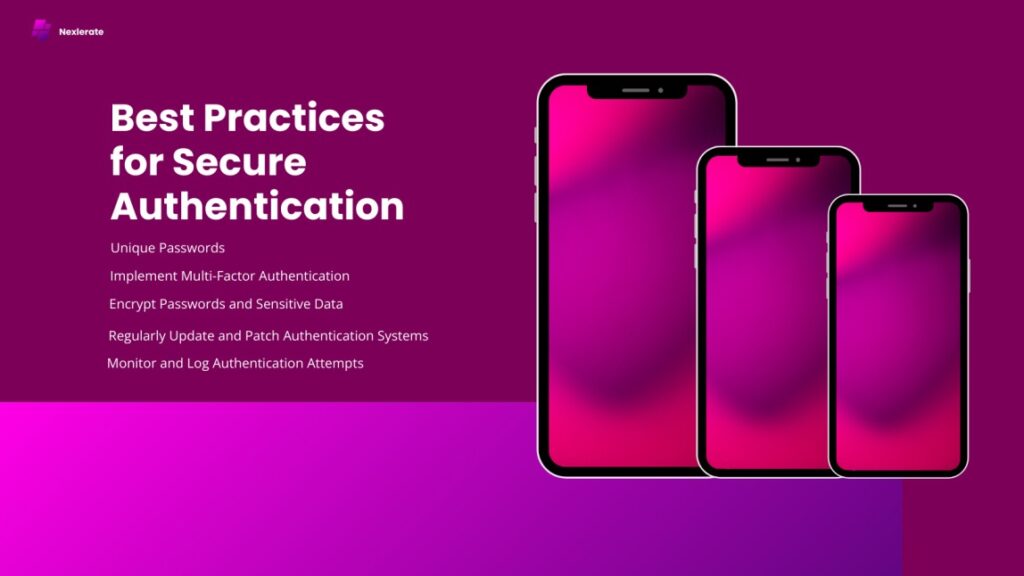Introduction
In today’s digital age, securing web applications is paramount. Poor authentication practices can expose your application to breaches and unauthorized access. This guide will walk you through implementing secure authentication methods to safeguard your web applications effectively.
Table of Contents
Understanding Authentication
Authentication verifies a user’s identity in web applications, ensuring that users are who they claim to be. It differs from authorization, which controls user access to resources.
Common Authentication Methods
- Username and Password: The most traditional method where users provide a unique identifier and a secret password.
- Multi-Factor Authentication (MFA): Adds an extra layer of security by requiring additional verification methods, such as a code sent to a user’s phone.
- OAuth and Single Sign-On (SSO): Allows users to authenticate using credentials from another service, simplifying login processes.
- Biometrics: Uses unique biological traits like fingerprints or facial recognition for authentication.
Best Practices for Secure Authentication

- Use Strong, Unique Passwords: Encourage or enforce the use of complex passwords that are hard to guess.
- Implement Multi-Factor Authentication (MFA): Enhances security by requiring multiple verification steps.
- Encrypt Passwords and Sensitive Data: Ensure passwords are stored using strong encryption methods.
- Regularly Update and Patch Authentication Systems: Keep your systems updated to protect against new vulnerabilities.
- Monitor and Log Authentication Attempts: Track and analyze authentication attempts to detect and respond to suspicious activities.
Implementing Secure Authentication
Setting Up HTTPS
Using HTTPS is crucial for protecting data in transit. Implement HTTPS by obtaining an SSL/TLS certificate and configuring your web server to use it.
Secure Password Storage
Store passwords securely by salting and hashing them. Use strong hashing algorithms like bcrypt or Argon2 to protect against brute-force attacks.
Multi-Factor Authentication (MFA)
Implement MFA to add an additional layer of security. Popular MFA tools include Google Authenticator and Authy.
OAuth and Single Sign-On (SSO)
OAuth allows users to log in with credentials from other services. SSO simplifies user management and improves security by reducing password fatigue.
Authentication Libraries and Frameworks
Several libraries and frameworks can streamline the implementation of secure authentication:
- Auth0: A comprehensive solution for authentication and authorization.
- Firebase Authentication: Offers robust authentication services for mobile and web apps.
- Passport.js: A middleware for Node.js that supports various authentication strategies.
Testing and Auditing Your Authentication System
Regularly test your authentication system to identify vulnerabilities. Conduct penetration testing and security audits to ensure compliance with best practices and regulatory requirements.
Common Pitfalls and How to Avoid Them
- Weak Password Policies: Enforce strong password requirements.
- Ignoring MFA: Implement MFA to enhance security.
- Poor Session Management: Ensure sessions are properly managed and expired.
- Not Keeping Up with Security Updates: Regularly update your systems to protect against known vulnerabilities.
Case Studies and Real-World Examples
Learn from successful implementations and past breaches to understand the importance of secure authentication. Real-world examples provide valuable insights into best practices and common mistakes.
Future Trends in Authentication
Stay ahead by adopting emerging trends:
- Passwordless Authentication: Utilizes methods like biometrics and magic links.
- Advances in Biometric Authentication: Improving accuracy and security.
- AI and Machine Learning: Enhances authentication systems by detecting anomalies and adapting to new threats.
Conclusion
Secure authentication is vital for protecting your web applications. By following best practices and staying informed about new trends, you can ensure robust security for your users.
Additional Resources
For more detailed guides and tools, check out the following resources:
Call to Action
Implement these secure authentication practices in your web applications today. Share your experiences or ask questions in the comments below! Read Our Other Article.
